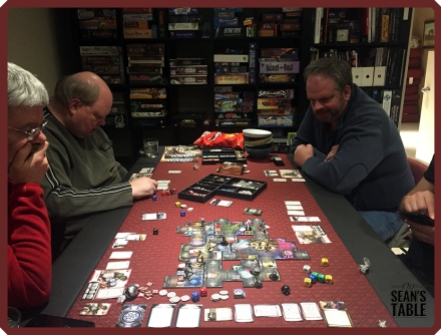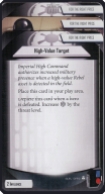Heart of the Empire: Played and Reviewed

We just finished our sixth Imperial Assault campaign. Big box expansion Heart of the Empire kept us busy through eight closely fought missions. Fantasy Flight Games continues to improve each campaign; the Thursday Night Gaming Group (TNGG) agreed that this was the best one yet due to some well considered tweaks to the campaign system. Join us as we look back on the Heart of the Empire campaign.
First off, here are some homegrown tweaks that made our campaigns more enjoyable. Rebel Heroes got one starting XP to be spent before the first mission. Prior to this tweak players felt they didn’t get enough of their class cards into play. While I don’t advocate making it a cakewalk for the Rebels everyone comes to the Thursday Night Game Groups to enjoy themselves. This little bump for the players gave a greater sense of character development at no real cost to me as the Imperial overlord.
After a couple of missions, I started sharing maps and initial mission objectives a few days in advance if I managed to get things set up in time. I simply forwarded a photo of the board and mission text. Foreknowledge of the battlefield and conditions was really skewing things toward the Empire in the first few missions. Foreknowledge helped the Rebels out. The missions were still close but instead of constantly improvising on the fly – often to the exclusion of attaining key objectives – the Rebels got a chance to coordinate better. Things still felt desperate for the Rebels and they were always pressed for time, activations, movement, and attacks but the tweak gave players at least the feeling of having more control over their fate.
With such a range of side missions now available (er, mostly because I keep buying all the expansions) the structure of campaigns has become increasingly less focused. I knew we needed a change, even as far back as the Hoth campaign, when side and character missions had us doing a freeze-and-bake cycle where we’d do a Hoth mission and then end up with a side mission somewhere on Tatooine. Since then we’ve stuck to loading the side mission deck with Hero missions only. Because players usually choose new heroes from the current expansion, side missions now stay focussed on the campaign location with only the occasional off-world hop. Players like this as well because it gives each of the heroes their chance to shine and have a crack at earning their special reward card or ability.
The final tweak – and I think maybe one tweak too many – was allowing players to choose the Imperial Class deck they wanted to face from the two new ones in the Heart expansion. There are some Imperial class decks that bleed the fun out of the game and I wanted to make sure that if the two Heart of the Empire Imperial decks were really tough at least the one they faced was of their own choosing. They chose (predictably!) the Reactive Defenses deck over the Power of the Dark Side. Having played a full campaign with it:
I can say with confidence, Reactive Defenses is not a weak deck.
This deck nickles-and-dimes damage output, movement, and defense at a consistently punishing rate. Played well it is the closest thing the Empire has to a “support role” hero like Gideon Argus and Murne Rin. It is, however, fiddly: Reactive Defenses requires a keen memory to ensure that all the little buffs and debuffs are used to best effect by the end of the round. In the final analysis I’m a “spend-it-all-at-once” kind of player and found this nickel-and-dime approach a difficult fit and not in my wheelhouse.
I think you can see from the tweaks that we’ve implemented we’re running the Imperial Assault campaigns along the lines of a Role Playing Games (RPG) in terms of desired outcome. My goal as GM/Imperial Overlord is first and foremost to make sure that everyone has a good time. I figure if my players are going to commit the time it takes for a long-term campaign it’s my job to make sure every player gets at least one mission where they can shine and we do as much as possible to make sure everyone comes away happy. To be clear, part of this is to make sure the Empire wins several times along the way. As GM I’m one of the players and losing all the time is not fun plus there’s nothing like coming up just short to motivate the heroes during the next mission. I’ll be picking my own class deck in the future as, in retrospect, I would have much rather used Palpatine and his Embrace Anger, Fear, and Suffering tricks. I’ll pick my own Imperial class deck next time – thank you very much – but apart from that I think we’ve hit a sweet spot in terms of campaign structure and risk Vs. reward for all players.
The two Influence Card Sets from Heart of the Empire earned their keep. Surveillance Cams from the Security Protocols set came in handy later in the campaign when it was clear that one hero (either Drakkota or Jarrod) was going to be a serious road block. This allowed a concentrated effort against that hero until they were wounded. Likewise, Heavy Riot Gear can keep your Storm or Riot Troopers alive just that little bit longer. I also took For the Right Price cards for High Value Target and Imperial Industry for the Restorative Supply cards. These two influence card sets are auto includes for me because once you’ve got those two key cards they pay enough dividends to change the outcome of any given mission.
The new Field Commander Influence set came with the very handy Assault Coordination and Reinforcements En Route. Elite Imperial Officers gained even more utility through dishing out three damage tokens or adding Influence at the start of each status phase. These joys are short-lived, however, as leaders sporting these abilities become high priority targets and rarely last a turn. Effective, however, for those missions where you get to bring in a named leader like Vader or Palpatine for the rare occasion where they have an action to spare.

The supporting cast for both Empire and Rebels was the usual array of expansion themed characters. I really enjoyed playing with the Riot Troopers and the Sentry Droids were universally feared by players with their dual attacks. My favourite – although I didn’t get them on the table as often as I would have liked – was the Clawdite Shapeshifter. Getting the most out Clawdites added to the already memory intensive Class Deck I was playing – you could choose a new form with different abilities each round – but the shapeshifter was really fun to play and very thematic. Palpatine, Maul, and Tano are the figure packs released with this expansion wave. All three are extremely powerful and dominated the missions in which they appeared.
Before moving on to the heroes here’s a quick tour of the three key new rules implemented by Heart of the Empire.
- Rubble Tokens reshaped the battlefield during several missions and were a mainstay of the hero Drokkata’s abilities. They are difficult terrain costing two movement points to leave and when dropped on or beside figures usually caused damage.
- Shield Tokens didn’t play a huge role in our campaign. They block line of sight but have no impact on movement or adjacency. They were an option for the Empire playing the Reactive Defences deck but I rarely used them. They did provide a shelter from ranged attacks when figures needed to hide.
- Power Tokens became available as either active or passive abilities. For example, the 88-Z droid central to the Reactive Defenses Imperial class deck had the very powerful ability of using an action to give other figures a surge power token. Elite Imperial Officers with the surge: stun ability and Probe Droids gleefully used their bonus surge. Riot Troopers were granted a block token at the end of their activations making them even tougher to remove from the board. Power tokens came in four denominations – surge, damage, dodge, block – and featured prominently in most Heart of the Empire figures, decks, and missions.
We played with two of the three new heroes from Heart of the Empire. Fenn Signis and Murne Rin rounded out the foursome. John’s Fenn was a real menace throughout. Take Cover and Lone Wolf kept him in high gear even when he was the target of the Empire’s attentions. Murne turned out to be a real game changer. Seth used Sonic Bellow and False Orders on an annoyingly regular basis to really make a mess of my Imperial plans. If you haven’t fielded a support character yet give Murne Rin a try. You won’t be disappointed.
Duncan’s Jarrod Kelvin was deadly on both offense and defense. Once tooled up I had to focus on him to the exclusion of all else for an entire round or two in order to wound him. Parry on defense and the use of his companion droid J4X-7 to both grant pierce and do some damage of his own made him a tough customer. He couldn’t dish the damage like Drokkata but Jarrod is durable, mobile, and plays a good point man as well as support character. During a later mission he was almost single-handedly responsible for chasing Vader himself off the board!
It was Mark’s Drokkata though that regularly wrecked the Empire and my best laid plans. I think the moment of the campaign was when he reduced a healthy AT-DP with 16 health into a smoking pile of scrap that only a Jawa could love. I had saved it’s activation until last so I could have a hero put themselves in the way of its massive-damage-multiple-attacks and then use Restorative Supplies to cackle like Palpatine while gaining back a bunch of health and doing it all again the next round. Alas, it wasn’t to be. A fully tooled up Drokkata does five damage before rolling a die, and then benefits from multiple surges to trigger at least pierce 2 and a whole boatload of other auto and blast damage. My poor AT-DP didn’t stand a chance. I don’t think another Rebel hero can match Drokkata’s ability to one-shot any single Imperial model and splash so much damage around in the process.
Ko-Tun Feralo got beat out for the support role slot by Murne Rin. She has four endurance, with no XP card to give her more, and is very dependent on spending a lot of strain both during and outside her activation. Maybe in the right hands she’d be a menace but on paper she looks like you’d end up doing a lot of resting to clear strain, only to rack it up again to trigger abilities. That’s no fun!
Heart of the Empire was really enjoyable bringing some imaginative new wrinkles to a tested base formula. I’m looking forward to the next big box expansion and (after a healthy break) firing up a new campaign.
Some other posts on Imperial Assault that might interest you:
Jabba’s Realm: Campaign Wrap Up
Imperial Assault: The Emperor reveals the power of the pesky white defense die
Imperial Assault: How to Tweak a Campaign to Make it Better



















Pingback: Why I’m Playing my First RPG in 30 Years | On Sean's Table
Pingback: Tyrants of Lothal: Imperial Assault Swan Song | On Sean's Table
Good gameplay! Thanks for share!
LikeLiked by 1 person
You’re welcome, glad you found the content interesting and useful.
LikeLike